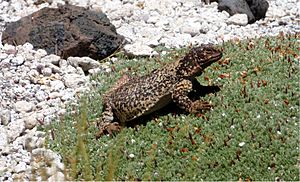Phymaturus antofagastensis facts for kids
Quick facts for kids Phymaturus antofagastensis |
|
|---|---|
 |
|
| Conservation status | |
| Scientific classification | |
| Genus: |
Phymaturus
|
| Species: |
antofagastensis
|
The Phymaturus antofagastensis is a cool type of lizard! It belongs to a family of lizards called Liolaemidae. This special lizard lives only in Argentina, a country in South America. It was first officially described in 1985.
Contents
About This Lizard
The Phymaturus antofagastensis is a fascinating reptile. Like all lizards, it is a cold-blooded animal. This means its body temperature changes with the temperature around it. Lizards often bask in the sun to warm up. They can also hide in the shade to cool down.
Where It Lives
This particular lizard is found in Argentina. Argentina is a large country with many different environments. The Phymaturus antofagastensis likely lives in specific areas within Argentina. These areas might include rocky places or dry, open lands. Lizards often choose habitats where they can find shelter from predators. They also need places to find food and bask in the sun.
What It Looks Like
While we don't have a detailed description here, most lizards in the Phymaturus group have flat bodies. They often have rough, scaly skin. Their colors can vary, helping them blend in with their surroundings. This is called camouflage. It helps them hide from animals that might want to eat them. It also helps them sneak up on their own food.
What It Eats
Many lizards, especially those in the Phymaturus genus, are herbivores. This means they eat plants. They might munch on leaves, flowers, or small fruits. Some lizards are insectivores, eating insects. Others are omnivores, eating both plants and insects. The diet of the Phymaturus antofagastensis helps it survive in its Argentine home.
Life Cycle and Reproduction
Lizards like the Phymaturus antofagastensis reproduce by laying eggs. Female lizards find a safe spot to lay their eggs. This could be in the soil or under rocks. The eggs then hatch into tiny baby lizards. These young lizards look like smaller versions of their parents. They grow bigger over time. Lizards go through a life cycle of hatching, growing, and then reproducing themselves.
Protecting This Lizard
The Phymaturus antofagastensis is listed as "Least Concern" (LC) by the IUCN. This means it is not currently in danger of disappearing. However, it's always important to protect all animals and their habitats. Keeping their homes safe helps these amazing creatures thrive.
See also
 In Spanish: Phymaturus antofagastensis para niños
In Spanish: Phymaturus antofagastensis para niños


